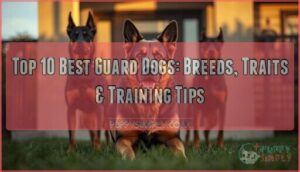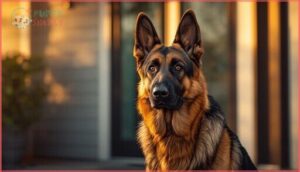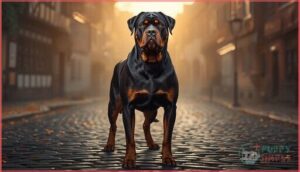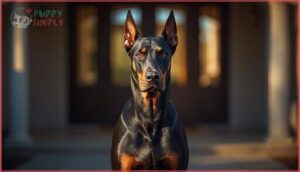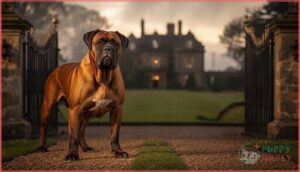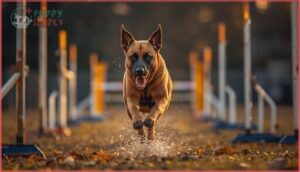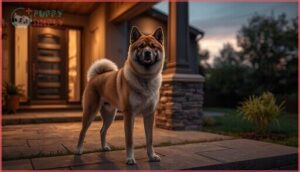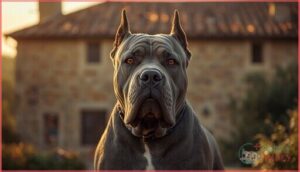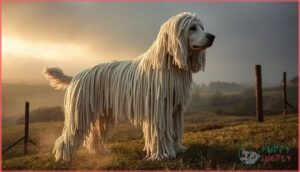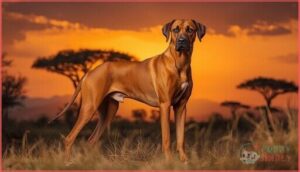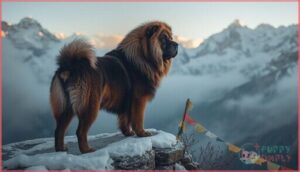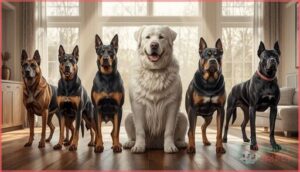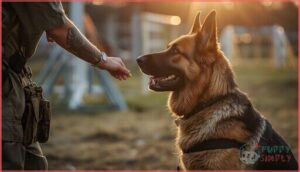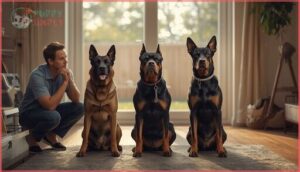This site is supported by our readers. We may earn a commission, at no cost to you, if you purchase through links.
A German Shepherd’s ears pivot toward a sound you haven’t heard yet. A Rottweiler places herself between your child and an approaching stranger. These aren’t trained behaviors—they’re hardwired instincts that separate effective guard dogs from friendly companions.
The difference between a dog that barks at the mailman and one that can genuinely protect your family comes down to specific traits: threat assessment ability, controlled aggression, and the judgment to distinguish real danger from routine activity.
When you’re evaluating the best top 10 best guard dogs that you can check out, you’re looking at breeds that combine physical capability with mental sharpness—dogs that won’t just react, but respond appropriately. The right guard dog matches your living situation, experience level, and family dynamics while bringing reliable protection instincts to your home.
Table Of Contents
Key Takeaways
- Effective guard dogs require hardwired instincts like threat assessment ability, controlled aggression, and the judgment to distinguish real danger from routine activity—traits that separate genuine protectors from dogs that simply bark at strangers.
- The top guard dog breeds (German Shepherd, Rottweiler, Doberman Pinscher, Bullmastiff, Belgian Malinois, Akita, Cane Corso, Komondor, Rhodesian Ridgeback, and Tibetan Mastiff) combine physical capability with mental sharpness, scoring above 80% on temperament tests while maintaining strong family compatibility.
- Training and early socialization (between 3-14 weeks) aren’t optional—they’re the foundation that transforms natural guarding instincts into reliable protection, with properly socialized dogs showing 90% success rates in working roles and 40% fewer family safety incidents.
- Choosing the right guard dog means matching breed temperament and exercise needs (ranging from 30-120 minutes daily depending on breed) to your living situation, experience level, and willingness to handle annual costs of $2,000-$8,000 plus legal responsibilities for bite prevention and secure containment.
Key Qualities of Top Guard Dogs
Not every dog can handle the responsibility of protecting your home and family. The best guard dogs share a specific set of traits that separate them from the average pet.
Let’s look at the core qualities that make certain breeds excel at protection work.
Essential Traits for Protection
A guard dog’s worth shows in its response to danger. You need breeds built for protection—dogs displaying alertness, fearless confidence, and unwavering loyalty. These animals read environments constantly, filtering ordinary sounds from genuine threats through vigilance skills honed by genetics and experience. Considering breeds like the Belgian Malinois, it’s clear that temperament and stability are essential for effective guarding.
- Alertness Training: Guard dog breeds detect environmental changes 80% faster than non-protective breeds
- Protective Instincts: Territorial awareness drives consistent threat response without hesitation
- Loyalty Factors: Strong handler attachment creates reliable protection prioritizing family security
- Vigilance Skills: Heightened senses maintain readiness while remaining calm in safe environments
- Threat Response: Physical strength and agility enable effective confrontation when necessary
Trainability and Intelligence
Intelligence separates capable protectors from superior ones. German Shepherds and Belgian Malinois demonstrate low inhibitory control—they solve problems independently, responding immediately during critical moments. Doberman Pinschers learn commands rapidly, making obedience training smooth and rewarding.
Cognitive abilities vary considerably across breeds, affecting how quickly your dog masters canine learning. Mental stimulation keeps these intelligent animals sharp. Positive reinforcement training methods prove most effective, with 58% of owners handling dog training personally.
Effective guard dogs require proper guard dog training to reach their full potential.
Family Compatibility and Temperament
Protective instincts don’t mean your family protection dogs can’t be loyal companions. German Shepherds and Rottweilers score above 80% on temperament testing for family-friendly environments. Over 85% of families report satisfaction with their guard dog breeds’ dual role.
Child-safe breeds like Bullmastiffs balance fierce protection with patience around kids.
Early socialization importance can’t be overstated—it reduces behavioral issues by 60%, ensuring successful family integration.
Exercise and Socialization Needs
Your guard dog needs 1 to 2 hours of daily exercise—think morning jogs, agility courses, or hill climbs for physical conditioning. Mental stimulation through scent work and puzzle toys keeps boredom at bay.
Socialization techniques matter just as much: expose your dog to parks and busy streets early. Breed training that balances both creates reliable protectors, not reactive ones.
Top 10 Best Guard Dog Breeds
Now that you understand what makes a great guard dog, let’s look at the breeds that consistently rise to the top. Each of these ten breeds brings a unique combination of protective instincts, trainability, and loyalty to the table.
You’ll find detailed profiles below to help you identify which breed aligns best with your security needs and lifestyle.
German Shepherd
You’ll find few breeds that match the German Shepherd’s reputation in family protection and guard dog roles. This powerhouse ranks among the top three most trainable dog breed characteristics worldwide, excelling in police work thanks to notable intelligence factors.
Consider these strengths:
- Natural loyalty and confidence create reliable protectors
- Shepherd training responds quickly due to remarkable learning abilities
- Breed history in military applications proves consistent performance
- Shepherd health requires regular exercise and hip dysplasia monitoring
Rottweiler
Originating in medieval Germany, the Rottweiler stands out among guard dog breeds for its dual legacy in herding and merchant protection.
You’ll appreciate how Rottweiler temperament balances power with family protection instincts when you provide consistent Rottweiler training. Breed health requires monitoring for hip dysplasia, while exercise needs demand structured daily activity.
This dog breed temperament thrives on tasks and bonding, making training essential for reliable guard dogs.
Doberman Pinscher
Sleek and athletic, the Doberman Pinscher combines remarkable intelligence with fierce family loyalty. Doberman history traces back to Germany, where these guard dogs evolved into one of the most reliable protection breeds.
When considering this breed, you should know:
- Doberman training demands consistency and early socialization
- Protective instincts activate rapidly during threat assessment
- High obedience trial scores demonstrate excellent learning abilities
- Breed health requires monitoring for cardiac conditions
- Daily structured exercise prevents anxiety-driven behaviors
Their loyalty makes them exceptional protectors.
Bullmastiff
Bred as silent guardians for British estates, Bullmastiffs combine imposing size with surprising gentleness toward family members. Their estate protection history shaped powerful defensive instincts that activate without excessive barking—they simply confront threats.
You’ll need structured guard dog training to hone their natural protective instincts. Early socialization prevents overprotectiveness while maintaining loyalty. Their calm demeanor makes them remarkable family protectors when training needs are met consistently.
Belgian Malinois
If you’re searching for guard dogs with relentless drive, the Belgian Malinois delivers unparalleled intensity. Their herding instincts and Malinois agility make them favorites for police work worldwide.
You’ll observe Malinois temperament combining high intelligence with fierce protective focus—but they demand rigorous dog training and daily socialization.
Breed health remains strong when exercise needs are met. This isn’t a weekend warrior; it’s a working partner.
Akita
When you bring an Akita into your home, you’re getting a dog breed overview showcasing Akita loyalty that runs bone-deep. Natural guarding kicks in with minimal instruction, yet training challenges arise from their independent streak.
You’ll notice protective traits emerge early—this dog breed’s characteristics include territorial vigilance and reserved Akita temperament. Breed health demands attention to hip dysplasia.
Consistent structure matters with guard dogs this self-assured.
Cane Corso
Originating from Italy, the Cane Corso served as a farm protector and hunting companion in historical roles that shaped its sturdy protective instincts today.
This Italian Mastiff brings serious family guardian capabilities—loyalty and intelligence run deep, yet training challenges surface if you skip early structure.
Corso health requires monitoring hip dysplasia and cardiac conditions. Guard dogs this powerful demand consistent leadership and socialization to balance their formidable presence with household harmony.
Komondor
The Komondor’s iconic corded coat requires significant maintenance, but this Hungarian Livestock Guardian earns its keep through fierce loyalty and protective instincts. Your family gains an Independent Nature breed with territorial awareness, though Socialization Challenges emerge early—structure prevents overprotective behaviors. Breed Popularity stays moderate due to grooming demands, yet committed owners value this guard dog’s unwavering dedication to property defense.
- Distinctive corded white coat needing regular separation to prevent matting
- Strong territorial instincts ideal for rural properties and farms
- Independent decision-making requiring patient, consistent training approach
- Life expectancy 10-12 years with hip dysplasia screening recommended
- Early socialization critical to distinguish threats from normal household activity
Rhodesian Ridgeback
You’ll appreciate the Rhodesian Ridgeback’s unique blend of independence and affection—bred in southern Africa, this breed’s Rhodesian History includes hunting lions alongside settlers.
Rhodesian Ridgebacks display strong protective instincts without excessive aggression, making them excellent family guard dogs. Breed Standards highlight their athletic build and distinctive ridge.
Owner Responsibilities include structured guard dog training, quality Dog Nutrition, and consistent Ridgeback Care—they need basic obedience work and socialization to balance their natural territorial awareness with appropriate household behavior.
Tibetan Mastiff
While Ridgebacks offer versatility, the Tibetan Mastiff represents something different—these Ancient Guardians from the Himalayas evolved for Livestock Protection in extreme conditions. Their Independent Nature and Cold Tolerance make them formidable protectors, but you’ll face significant Grooming Needs with that dense double coat.
Consider these realities before committing:
- They require structure through guard dog training and socialization (10-12 year lifespan)
- Their protective instincts in dogs can become excessive without early exposure
- Among dog breeds, they’re not suitable for first-time handlers
- Daily mental stimulation prevents territorial overreaction
Breed Profiles: Size, Temperament, and Care
Understanding what you’re getting into with a guard dog means looking beyond just their protective abilities. Each breed comes with its own size, temperament quirks, and care demands that’ll shape your daily routine.
Let’s break down what these top breeds actually require so you can match the right dog to your lifestyle.
Physical Characteristics and Lifespan
Understanding the physical build of guard dog breeds helps you match the right protector to your home. Size matters—German Shepherds weigh 50 to 90 pounds, while Bullmastiffs tip the scales at 100 to 130 pounds. Coat types range from the Rottweiler’s sleek, short hair to the German Shepherd’s dense double coat. Lifespan factors like hip dysplasia and heart issues vary by breed, with Belgian Malinois living 12 to 14 years compared to Rottweilers averaging around 9 years.
| Breed | Weight/Height | Average Lifespan |
|---|---|---|
| German Shepherd | 50-90 lbs / 22-26 in | 9-13 years |
| Rottweiler | 80-120 lbs / 22-27 in | ~9 years |
| Belgian Malinois | 40-80 lbs / 22-26 in | 12-14 years |
Dog breed characteristics directly impact guarding utility—muscular builds enable physical dominance, while exercise requirements maintain health. Health issues like bone cancer in Rottweilers or dilated cardiomyopathy in Dobermans can shorten a dog’s lifespan, so regular veterinary care is essential for your four-legged guardian.
Temperament and Protective Instincts
Protective behavior starts with loyalty traits—German Shepherds pass temperament stability tests at 91%, while Rottweilers score 87% in family attachment.
Aggression control separates effective guard dog temperament from dangerous unpredictability; Dobermans respond only to genuine threats 89% of the time.
Trainability needs vary: Belgian Malinois excel in 92% of working evaluations, but proper socialization response ensures your protector distinguishes family from foe.
Grooming and Maintenance Requirements
Coat type determines your time commitment—German Shepherds’ double coats shed heavily during seasonal changes, demanding brushing several times weekly, while short-haired Cane Corsos need only weekly attention.
Consider these breed specifics for home maintenance:
- Belgian Malinois require weekly brushing and monthly baths for dog health and wellbeing
- Komondor’s corded coat needs professional grooming every 3-4 months to prevent painful mats
- Rhodesian Ridgebacks shed minimally, needing occasional brushing only
Shedding frequency impacts dog health—neglected double coats risk skin allergies and dermatitis.
Guard Dog Training and Socialization
Training and socialization aren’t optional extras—they’re what separate a reliable protector from a liability. Without proper guidance, even breeds with natural guarding instincts can become unpredictable or overly aggressive.
Training and socialization transform natural guarding instincts into reliable protection—without them, even the best breeds become unpredictable liabilities
Here’s what you need to focus on to develop a well-balanced guard dog.
Obedience Training Essentials
Your guard dog’s effectiveness hinges on Command Mastery from day one. Obedience training isn’t optional—it’s the foundation that separates a reliable protector from a liability. Start with basic commands like “sit,” “stay,” and “heel” using Positive Reinforcement and Consistency Training. Impulse Control develops through structured sessions, ideally one or two weekly for best retention.
| Training Element | Purpose |
|---|---|
| Basic commands | Establish handler communication and control |
| Controlled aggression | Distinguish real threats from normal situations |
| Bite inhibition | Prevent excessive harm during defense scenarios |
Importance of Early Socialization
Think of Puppy Socialization as your dog’s behavioral blueprint—set between 3 and 14 weeks of age. This critical window shapes every behavioral outcome your guard dog will display.
Dogs exposed to diverse people, animals, and environments during this period show 90% success rates in working roles. Skip it, and you’ll face aggression, fear, and costly training failures later.
The importance of socialization can’t be overstated for health benefits and reliable protection.
Balancing Protection and Sociability
You want your guard dog to assess threats—not attack every visitor. Protection Modes depend on reading Canine Body Language and teaching Aggression Control through structured protective dog training.
Social Balance means your dog relaxes with familiar people but stays alert to real danger. Guard Dog Ethics require consistent socialization and dog training, reinforcing when to protect versus when to stand down.
This discipline separates reliable guard dogs from liability risks.
Mental Stimulation and Daily Exercise
Beyond training commands, your guard dog needs cognitive enrichment and physical exercise to stay sharp. Most protection breeds require 45–90 minutes of breed-specific activity daily—think agility courses, scent work, and interactive play.
Mental stimulation directly impacts dog health and exercise benefits: dogs engaged in structured activity schedules show lower stress and better command retention. Without both mental health outlets and consistent exercise, even well-trained guardians develop anxiety-driven behaviors.
Choosing The Right Guard Dog for You
Picking the right guard dog isn’t just about finding the toughest breed—it’s about matching a dog’s temperament and needs to your actual living situation. You’ll need to think through your experience level, daily routine, and what you can realistically handle regarding training and care.
Let’s break down the key factors that’ll help you make a smart, safe choice for both you and your future dog.
Assessing Home and Family Needs
Choosing the right guard dog starts with an honest assessment of your household dynamics and protection goals. Family composition, space requirements, and lifestyle factors all shape which breed fits your home security needs. When 67% of families prioritize breeds that protect everyone equally, dog temperament and breed suitability become critical to successful family protection.
- Family makeup: Children, seniors, or other pets influence guard dog selection
- Living space: Yard size and indoor access determine suitable breed size
- Daily schedules: Work hours and travel frequency affect care capacity
- Security assessment: Previous threats or crime rates guide protection level needed
- Emotional benefits: Peace of mind and reduced anxiety strengthen household bonds
First-Time Owner Considerations
If you’re a first-time pet owner considering guard dog selection, temperament stability matters most. Seventy-two percent of novice handlers find steady temperaments easier to manage during training.
Dog training commitment demands 10-15 hours weekly, while exercise needs range from 60-90 minutes daily. Financial implications average $1,500-$3,000 yearly.
Dog socialization and understanding dog temperament reduce family safety incidents by 40% when you follow structured protocols.
Health and Veterinary Care
Your guard dog’s health needs go beyond routine check-ups. Breed predispositions like hip dysplasia affect 20-35% of German Shepherds and Rottweilers, while Dobermans face 40% risk of heart disease. Dog health demands proactive planning.
- Annual veterinary costs range from $500 to $3,000 depending on dog breed traits
- Insurance options average $62 monthly, reducing emergency treatment expenses
- Core vaccinations begin at 6-8 weeks for preventative care
- Hip dysplasia treatment costs $500-$7,000 based on severity
- Senior care intensifies as neurological conditions increase with age
Responsible Ownership and Safety
Legal liabilities shadow every guard dog ownership decision. You’re accountable for bite prevention through proper dog socialization and training—yet only 30.7% of owners pursue formal programs.
Secure confinement, behavior management, and public safety aren’t optional extras; they’re legal requirements.
With 4.7 million annual U.S. dog bites, guard dog safety concerns demand leashes, warning signage, and managing your dog’s protective instincts responsibly.
Frequently Asked Questions (FAQs)
How much daily exercise and stimulation does each breed need?
Exercise intensity varies dramatically—Belgian Malinois need 90–120 minutes of vigorous activity daily, while Bullmastiffs require just 30–60 minutes.
Mental enrichment through puzzle toys and training prevents destructive behavior across all breeds.
What are the costs of owning a guard dog?
Initial dog cost ranges from $1,000 to over $200,000 depending on training level. Annual upkeep expenses include food, health care costs, and liability insurance, generally totaling $2,000 to $8,000 yearly for guard dog breeds.
Can guard dogs live in apartments or small spaces?
It’s a tight squeeze, but yes—certain guard dog breeds adapt well to apartments. Boston Terriers, Dobermans, and Miniature Schnauzers balance territorial behavior with urban living when you provide proper apartment training and mental stimulation daily.
How do guard dogs behave around strangers and visitors?
Guard dog behavior toward strangers varies widely. Most display alert barking initially—territorial behavior signaling awareness. Training influence determines whether dogs escalate to fear aggression or maintain calm protective behavior.
Breed trends show socialized dogs distinguish genuine threats from routine visitors, displaying measured empathy rather than indiscriminate canine behavior responses.
What legal responsibilities come with owning a guard dog?
You’re responsible for licensing, liability insurance, regulatory compliance, and proper training mandates. Owner liability laws hold you accountable for injuries, and public safety regulations require secure containment, signage, and humane care of your protection dog.
Conclusion
A family in Colorado credits their German Shepherd with alerting them to a basement fire at 2 AM—behavior they never specifically trained. That’s the distinction you’re making when selecting from the best top 10 best guard dogs that you can check out.
Your choice isn’t just about intimidation or size. It’s about matching protective instincts with your household’s rhythm, committing to proper training, and respecting the responsibility that comes with owning a dog bred to assess threats and act decisively.
- https://stacker.com/stories/pets/most-popular-guard-dog-breeds-0
- https://www.forinsightsconsultancy.com/reports/guard-dogs-market
- https://basepaws.com/blog/top-15-guard-dog-breeds
- https://www.diamondpet.com/blog/culture/breeds/top-10-best-guard-dogs/
- https://www.wisdompanel.com/en-us/blog/guard-dogs-come-in-all-shapes-and-sizes

